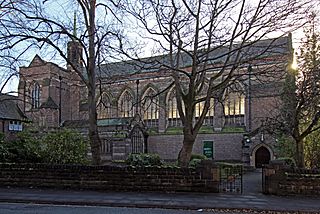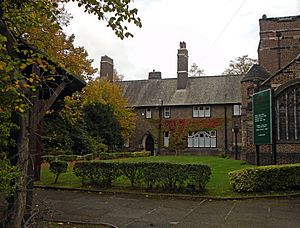St Clare's Church, Liverpool facts for kids
Quick facts for kids Church of St Clare, Liverpool |
|
|---|---|
 |
|
| 53°23′28″N 2°56′12″W / 53.3910°N 2.9367°W | |
| OS grid reference | SJ 378 886 |
| Location | Liverpool, Merseyside |
| Country | England |
| Denomination | Roman Catholic |
| Website | https://sschliverpool.org.uk/ |
| History | |
| Status | Parish church |
| Founder(s) | Francis and James Reynolds |
| Consecrated | 1890 |
| Architecture | |
| Functional status | Active |
| Heritage designation | Grade I |
| Designated | 28 June 1952 |
| Architect(s) | Leonard Stokes |
| Architectural type | Church |
| Style | Gothic Revival |
| Groundbreaking | May 1888 |
| Completed | June 1890 |
| Construction cost | £7,834 |
| Specifications | |
| Capacity | c. 600 |
The Church of St Clare is a beautiful Roman Catholic church located in the Sefton Park area of Liverpool, England. You can find it at the corner of Arundel Avenue and York Avenue. This church is very special because it's a "Grade I listed building." This means it's considered one of the most important historic buildings in the country!
It's also the only Roman Catholic church in the entire Archdiocese of Liverpool that has this top Grade I listing. Experts say it's "one of the most imaginative churches of its date in the country." It's still an active parish church, meaning people go there for services regularly.
Contents
History of St Clare's Church
Building the Church
The Church of St Clare was built between 1888 and 1890. Two brothers, Francis and James Reynolds, paid for it. They were cotton brokers, which means they bought and sold cotton for a living. The church cost £7,834 to build, which was a lot of money back then!
The person who designed the church was Leonard Stokes. He was Francis Reynolds' godson. Many people think this church was Stokes' first really amazing church design.
Key Dates in Construction
The first stone, called the foundation stone, was laid on March 25, 1889. The church was officially made sacred, or consecrated, on June 3, 1890. It opened for people to worship there on July 20, 1890. The company that built the church was Morrison and Sons, from a place called Wavertree.
Architecture and Design
Outside the Church
The Church of St Clare is built from a light brown, buff-coloured brick. It has decorative strips and details made of Storeton stone. The roof is made of slate. The church is built in the Gothic style, which is a popular design for old churches with pointed arches and tall windows.
The church has one main open space, called a vessel. It also has a small north transept (a part that sticks out like the arms of a cross). At the east end, there are two long, low chapels, one to the north and one to the south. There are also two porches, one on each side of the west end. Along the south wall, you'll find confessionals, which are small rooms for private confessions.
The front (west) side of the church is simple. It has a very large window with seven sections of glass. The porches have pointed roofs, called gables. Above the north doorway, there's a small space, or niche, with a statue of St Clare. In the same spot on the south porch, there's a statue of St Francis.
The south chapel is called the Sacred Heart Chapel. It has its own unique roof shape, called a saddleback roof, and four round-topped windows, each with five sections. The north chapel is the Lady Chapel, and it has a large west window with seven sections. The back (east) side of the church is also simple. It has a short, wide window with nine sections, but the two outer sections on each side are just for show.
The transept has a pointed roof and one window with three sections. There's also a small tower with a cone-shaped roof that leads to the organ loft. In the corner where the main part of the church meets the transept, there's a small eight-sided tower with a copper flèche (a small spire).
Inside the Church
Inside the church, you'll see internal buttresses, which are strong supports built into the walls. These buttresses have openings that create narrow walkways, almost like aisles. Arches connect these buttresses and support balconies above. The inside of the church has ten sections, or bays, and a curved ceiling that looks like the inside of a wagon.
The main altar, built in 1890, is a large triptych. This is a piece of art with three panels. It features paintings and relief sculptures (sculptures that stick out from a flat surface) by artists Robert Anning Bell and George Frampton. The stone pulpit, where sermons are given, was also designed by Stokes. It has four sides of a hexagon with decorative openwork designs.
The font, used for baptisms, looks like a chalice (a special cup). It's made of alabaster (a soft, white stone) and has a copper cover. The beautiful marble altar rails were put in place in 1933. They stretch across the main part of the church and the chapels.
All around the church, you'll see the Stations of the Cross. These are oil paintings that were put up in 1892. In the chapels, there are statues of religious figures made by Mayer and Company from Munich.
The oldest stained glass window in the church is in the Sacred Heart Chapel. It's called the Sacred Heart window and was installed in 1906. Another window in the chapel, showing Catherine of Siena, was put in in 1912. The stained glass in the large east window, which shows the Crucifixion, was installed in 1908.
The organ loft, where the church organ is located, is above the Lady Chapel. The organ was built in 1892 by Steele & Keay of Burslem. It was later fixed up and improved in 1920 by Henry Willis & Sons.
The Presbytery
Right next to the church is a two-story building called the presbytery. This is where the priest lives. It was also designed by Leonard Stokes and is a Grade II listed building, meaning it's also historically important. It's made of brick with a slate roof and connects to the north side of the church. Some people think the curved designs above the door look like the start of the Art Nouveau style, which was popular later.





